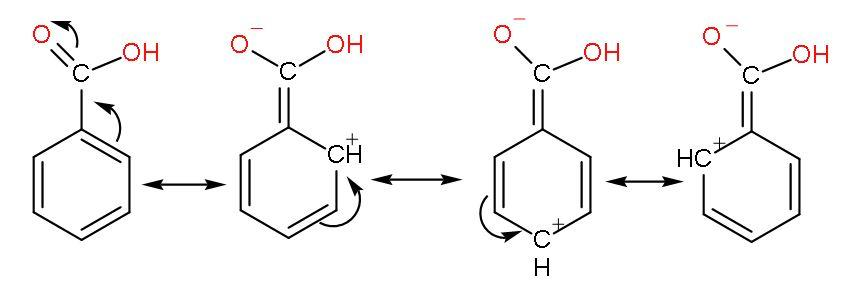
If
Ionic order:
Answer
505.2k+ views
Hint: The acidic strength is decided by its ability to produce hydrogen ions or
Complete step by step answer:
(1) Formic acid or

Formic acid has good acidic strength because there is such no presence of methyl groups in this acid. No methyl groups so, no inductive effect. When species have the tendency to donate electrons such as methyl or alkyl groups to a carbon chain, this charge is relayed through the chain and the effect is called the positive Inductive Effect. After losing

(2) Benzoic acid or

The phenyl group shows –I effect which attracts the electrons thus, helping in increasing the polarity of

But its resonance with benzene rings forms unstable carbocations due to incomplete octet of carbon atoms (have only 6 electrons) makes benzoic acid less acidic than formic acid.
It is clear that formic acid is more acidic than benzoic acid, so acidic order
Note: It is generally thought that aliphatic carboxylic acids are stronger acids than aromatic carboxylic acids also involved in resonance with the benzene ring. The
Complete step by step answer:
(1) Formic acid or

Formic acid has good acidic strength because there is such no presence of methyl groups in this acid. No methyl groups so, no inductive effect. When species have the tendency to donate electrons such as methyl or alkyl groups to a carbon chain, this charge is relayed through the chain and the effect is called the positive Inductive Effect. After losing

(2) Benzoic acid or

The phenyl group shows –I effect which attracts the electrons thus, helping in increasing the polarity of

But its resonance with benzene rings forms unstable carbocations due to incomplete octet of carbon atoms (have only 6 electrons) makes benzoic acid less acidic than formic acid.
It is clear that formic acid is more acidic than benzoic acid, so acidic order
Note: It is generally thought that aliphatic carboxylic acids are stronger acids than aromatic carboxylic acids also involved in resonance with the benzene ring. The
Recently Updated Pages
Master Class 12 Business Studies: Engaging Questions & Answers for Success

Master Class 12 English: Engaging Questions & Answers for Success

Master Class 12 Social Science: Engaging Questions & Answers for Success

Master Class 12 Chemistry: Engaging Questions & Answers for Success

Class 12 Question and Answer - Your Ultimate Solutions Guide

Master Class 11 Economics: Engaging Questions & Answers for Success

Trending doubts
Draw a labelled sketch of the human eye class 12 physics CBSE

a Tabulate the differences in the characteristics of class 12 chemistry CBSE

Which one of the following is a true fish A Jellyfish class 12 biology CBSE

Why is the cell called the structural and functional class 12 biology CBSE

Differentiate between homogeneous and heterogeneous class 12 chemistry CBSE

Write the difference between solid liquid and gas class 12 chemistry CBSE




